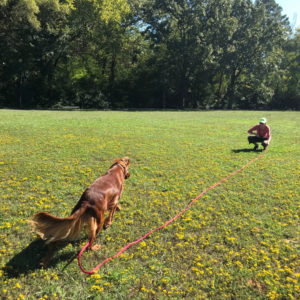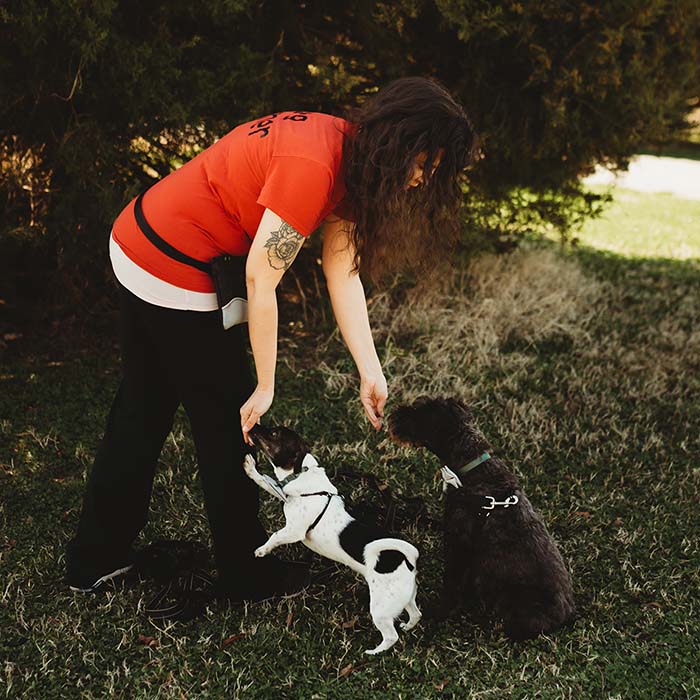Food and Dog Training
Shouldn’t my dog just do what I want?
Two weeks ago, I trained with a young couple and their young puppy. The dog sat immediately when I took a treat out of my pocket, and I was startled. “You’ve been doing some work, I see,” I told them.
A week ago, Jeeves cuddled up near me as I worked on my laptop. When I shut the laptop, it clicked, and Jeeves immediately jumped up and headed to the door.
Yesterday, I was training with a client and her two dogs. She reached for their harness to show me which one she used, and the dogs started pacing, getting excited.
All three of these situations have one thing in common: conditioning.
There’s something the dogs want, whether a treat, a quick trip outside, or a walk, that is always preceded by a specific behavior.
Dogs build associations. That’s why your dog gets excited when you grab the leash from the front door. When you always grab the leash and then always go on a walk, your dog starts to get excited just from seeing the leash, the same way my client’s dogs did. Whenever I close my laptop, that means I’m done working and I’m going to take Jeeves out, because I’ve done that consistently so many times. It doesn’t matter if I’d just taken him out fifteen minutes before. Dogs thrive on consistency.
This is also why clicker training is so popular, or even simply using a marker. I like to use the marker word “yes” or “good”, which is then followed by a treat. Once the dog is used to that word meaning something good, they start to anticipate, which also means good feelings and attention become attached to that word. This is how we fade out treats and create a pattern for an emergency, like when your dog is running down the street without a leash.
We can stop behavior using certain things, like adverse behavior. For example, if anybody were to hit a dog enough, he’ll learn to stop jumping up. But what’s missing there is trust. It’s also an example of failed communication. It’s a fearful response. That dog won’t learn a reliable recall in an emergency using the same technique, because the stimulus has been used to drive away. Some tools can reverse that response. For example, shock and e-collars are often used in the same way to train a recall, which drives the dog towards their owner instead of away, but it also takes away choices and trust. (I learned how to train through methods endorsed by the Certification Council of Professional Dog Trainers (CCPDT). The CCPDT’s official statement on electronic collars is here [PDF].)
Some of you have already heard me say in sessions, “Well, what do you want your dog to do?” It’s easy to say, “I want my dog to stop barking,” or “To stop begging at the table,” or “To stop pulling on a leash.” Instead, try reframing it as, “I’d like my dog to check in with me,” or “I’d like my dog to go to her place and lay down during dinner,” or “I’d like my dog to walk nicely next to me, checking in with me.”
That’s all possible, with foundational training behaviors.
Dog training can get incredibly technical and scientific, even nerdy, which is why I also like to explain things in terms of intuitive training, those who are simply good with dogs but can’t always explain why or what they did to get their results, and scientific-based training, which is often used by those who offer precise explanations and allows others to replicate results.
To this end, food is the quickest way to encourage a new behavior without force. I train from lure to physical/verbal cue, which means I’m asking for behavior, ultimately, without any food in my hand. This is where timing and fading out treats are especially important.
Learning how to do so can take some time. I’ll always remember the poor student in one of my classes, holding a bag full of high-value food while struggling to get a handle on his dog. Simply holding food doesn’t do much, especially if the dog can just take it away. With time, both he and the dog learned how to communicate, with the dog learning better manners.
But dogs don’t like certain treats or food at all. Sometimes they’re motivated by verbal praise, or affection, or toys, or balls, or just high-value treats like cheese. If we think of training in terms of a paycheck, while building positive associations, then we can understand how we encourage more good behavior, growing habits while developing life-long trust.
Commonly asked questions:
- But with treating all the time, my dog is going to get sick! How do I avoid harming my dog while giving her a paycheck?
Consider talking with your vet about alternatives, like dog-safe foods (carrots, pumpkins, blueberries), or reducing the amount of dinner to balance the number of treats. Also, use small pieces while treating. I NEVER recommend starving a dog for results. You can work with your vet on a balanced perspective to make sure your dog is remaining healthy while you train. Additionally, once your dog has advanced to more complicated behaviors, you can start to fade out treats or ask for combinations of behaviors (for example, “stick ‘em up” usually means the dog has to sit up, lay down, and stay down until released, which is three different behaviors combined, and can ultimately, eventually be treated only once, at the very end, once the dog understands.).
- Do I have to treat my dog forever?
See above! It is a good practice to use treats to train. Building up distance, duration, distraction, and location helps proof the behavior and get it reliable. Working up to a reliable recall takes time and high value treats, but practicing in a structured, safe environment means that you’ll be able to keep your dog safe in an emergency.
- My dog only behaves when he sees I have a treat in my hand. How do I get my dog to listen to me without holding a treat?
Rely on your marker word. Start with the treat in hand to lure the dog into a behavior, and once that is reliable, transition to a hand signal. For example, for a complete “down,” you’re standing straight up, pointing to the ground and saying “down”. Your dog should drop his elbows and hindquarters to the floor. But when beginning this behavior, we use a lure and gradually work our way up, moving the treat out of our hand. The marker word helps the dog understand the reward is coming, and helps build that positive association.
- My dog doesn’t listen right away! Is he being stubborn?
Maybe. Or maybe he needs a second. I ask my clients to wait a few seconds (sometimes as many as 10 to 20) before saying the command again. I also ask them to not say any words to start so everybody understands what is being requested. We’re human beings, so we like to talk a lot. We don’t even realize we’re doing it a lot of the time. I hear clients say, “Sit, sit, sit,” all while the dog is thinking it through. We’re teaching them they can sit the third time we say it, not the first time. So wait a few seconds. Let the dog think it through. Dog training is stress on the brain. It’s good stress, but it’s stress nonetheless. Let their brains catch up.
This is general advice, and if you’re struggling to communicate with your dog or establish behaviors, please consult a professional. Some dogs can’t lay down easily due to having very short or very long legs. Some dogs need to think through things before listening. Some dogs don’t want to work (dogs fail out of being guide dogs and K9s for a reason!). Be patient and ask for help if needed.
–
For further reading:
- Least Intrusive, Minimally Aversive (CCPDT Website)
- Food Changes Brain Chemistry (Stillwell Positively Website)
- Excel-erated Learning (Book by Pamela Reid)*
Next week: What certification am I working towards and why? PLUS: How to pick a trainer! Trainers are as varied in their approach, personality, and education as professionals in other fields — except there is no federal or state regulation. It can take some time to find the right fit.
Drop-in group classes take place every Saturday at SoMa Animal Clinic. I also offer private in-home lessons in the Little Rock area. Email me at info@telltaildogtraining.com for more information.
*These are not affiliate links. I receive no compensation for the recommendations listed here.



